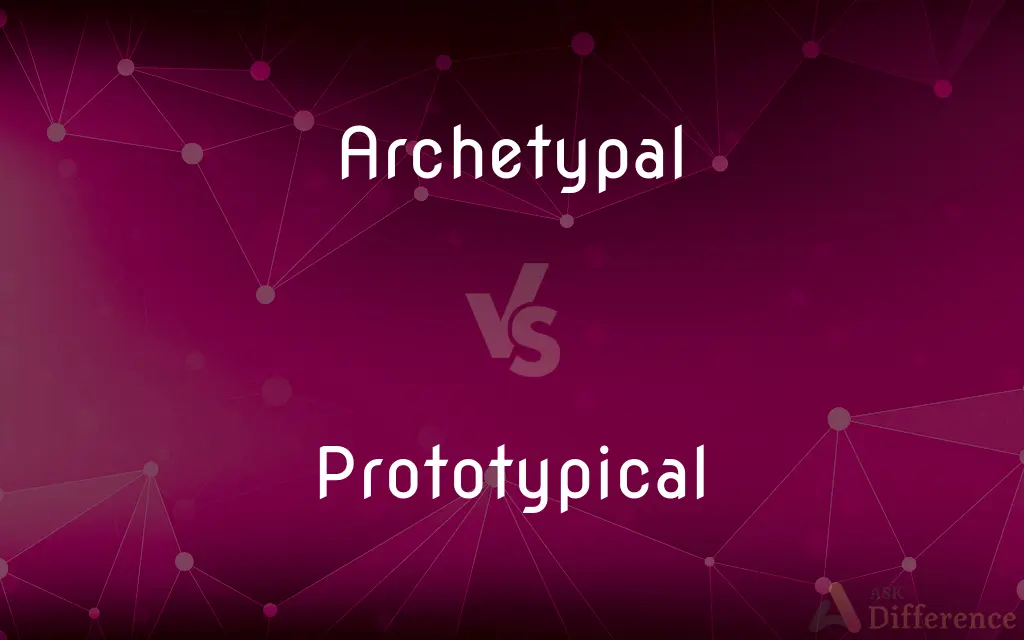Archetypal vs. Prototypical — What's the Difference?
Edited by Tayyaba Rehman — By Maham Liaqat — Updated on April 2, 2024
Archetypal refers to a very typical example of a certain person or thing, embodying universal patterns, while prototypical represents the first, typical or preliminary model of something.

Difference Between Archetypal and Prototypical
Table of Contents
ADVERTISEMENT
Key Differences
Archetypal concepts originate from psychology and literature, symbolizing universal, primordial images and themes that recur across cultures and time. These are foundational elements in storytelling and character development, representing universal experiences. On the other hand, prototypical concepts stem from fields like design and engineering, emphasizing the initial model or prototype that serves as a standard or benchmark for future versions.
Archetypes often convey complex ideas through simple, universally understood symbols or characters, such as the Hero, the Mentor, or the Trickster, which resonate across diverse cultures. Whereas prototypes are tangible models or drafts used in the development process of products, software, or theories, aimed at testing and refining the concept before finalizing it.
In literature and art, archetypal themes and characters play crucial roles in connecting audiences with the narrative by tapping into shared human experiences and emotions. Prototypical, however, is more frequently used in the context of product design and development, focusing on innovation and practical application rather than emotional connection.
Archetypal analysis can reveal deep insights into human psychology and societal structures by examining the recurring patterns and themes in myths, stories, and dreams. In contrast, prototypical analysis is crucial in the iterative design process, allowing for the evaluation and improvement of ideas through successive refinements.
While archetypes help in understanding the collective unconscious and the shared human psyche, prototypes are pivotal in the evolution of technology, design, and scientific understanding, showcasing the practical steps taken from concept to realization.
ADVERTISEMENT
Comparison Chart
Origin
Psychology, literature
Design, engineering
Function
Symbolizes universal patterns
Represents initial model
Context
Storytelling, character development
Product design, development
Connection
Emotional, universal experiences
Practical, innovation
Role in Development
Understanding human psyche, societal structures
Testing, refining concepts
Compare with Definitions
Archetypal
Serving as a model in storytelling.
Archetypal villains like the tyrant are common in fairy tales.
Prototypical
Serving as the original model.
The Wright brothers' airplane was prototypical of modern aircraft.
Archetypal
Symbolizing a universally recognizable character or theme.
The hero's journey is an archetypal narrative structure.
Prototypical
Used for initial testing.
The laboratory created a prototypical device for the experiment.
Archetypal
Embedded in the collective unconscious.
Archetypal symbols appear in dreams and myths across different societies.
Prototypical
Pioneering a design or theory.
The prototypical smartphone introduced touch screen technology.
Archetypal
Reflecting universal truths.
Archetypal themes such as birth, death, and rebirth are ubiquitous in literature.
Prototypical
Representing the standard model.
The prototypical nuclear family consists of two parents and their children.
Archetypal
Representing primal psychological patterns.
The Great Mother is an archetypal figure in many cultures.
Prototypical
Basis for future development.
Early electric cars were prototypical for today's electric vehicle technology.
Archetypal
An original model or type after which other similar things are patterned; a prototype
"'Frankenstein' ... 'Dracula' ... 'Dr. Jekyll and Mr. Hyde' ... the archetypes that have influenced all subsequent horror stories" (New York Times).
Prototypical
An original type, form, or instance serving as a basis or standard
"The abolitionists were the prototype of modern citizen activism" (Adam Hochschild).
Archetypal
An ideal example of a type; quintessence
An archetype of the successful entrepreneur.
Prototypical
An original, full-scale, and usually working model of a new product or new version of an existing product.
Archetypal
In Jungian psychology, an inherited pattern of thought or symbolic imagery derived from past collective experience and present in the individual unconscious.
Prototypical
A typical example of a class or category
"He fit the prototype of the artist as social misfit and compulsive contrarian" (Stephen Holden).
Archetypal
Of or pertaining to an archetype.
Prototypical
To make a prototype of (a product).
Archetypal
Of or pertaining to an archetype; consisting a model (real or ideal) or pattern; original.
Prototypical
Constituting or representing an original type of something that others are modelled on or derived from.
Archetypal
Representing or constituting an original type after which other similar things are patterned;
Archetypal patterns
She was the prototypal student activist
Prototypical
Representing or constituting an original type after which other similar things are patterned;
Archetypal patterns
She was the prototypal student activist
Common Curiosities
How does a prototype differ from a final product?
A prototype is an early model designed to test and refine concepts, often differing significantly from the final product as improvements and changes are made based on testing results.
Why are archetypes important in literature?
Archetypes are important in literature because they tap into universal experiences and emotions, allowing authors to connect deeply with audiences through shared human themes.
Can archetypes change over time?
While archetypes are universal and timeless, their expressions and interpretations can evolve with cultural and societal changes, reflecting contemporary values and issues.
What role do prototypes play in product development?
Prototypes are crucial in product development for testing, refining, and validating the design and functionality of a product before it enters mass production.
How do archetypes influence human behavior?
Archetypes influence human behavior by representing fundamental human desires, fears, and motivations, often guiding or influencing individuals' actions and decisions subconsciously.
What makes a prototype successful?
A successful prototype effectively demonstrates the feasibility, design, and functionality of a concept, allowing for necessary adjustments before final production.
How do prototypes impact user experience?
Prototypes impact user experience by providing a tangible model for user testing, enabling designers to refine usability and functionality based on real user feedback before finalizing the product.
Is there a limit to what can be considered archetypal?
The concept of what is considered archetypal is broad and encompasses a wide range of universal symbols and themes, but it is generally limited to those patterns that recur across cultures and time.
What is an archetypal character?
An archetypal character represents a universally recognizable and typical example of certain traits or behaviors, embodying universal patterns seen across various cultures and stories.
Can a concept be both archetypal and prototypical?
While concepts can share traits of being foundational or original, archetypal refers more to universal patterns and psychological symbols, whereas prototypical refers to the first model or basis for future designs.
What is the process of creating a prototype?
Creating a prototype involves designing a preliminary model or version of a product, which can then be tested and iterated upon based on feedback and functionality tests.
What's the significance of archetypal analysis in psychology?
Archetypal analysis in psychology is significant for understanding the deep structures of the human psyche, revealing the universal themes and patterns that shape human experience and behavior.
How often are prototypes updated before reaching the final design?
Prototypes can be updated numerous times before reaching the final design, depending on the complexity of the product and the results of each testing phase, emphasizing the iterative nature of design and development.
Are archetypes culturally specific?
While archetypes are based on universal patterns, their specific expressions and symbols can vary across cultures, reflecting different cultural values and narratives.
How do prototypes aid in innovation?
Prototypes aid in innovation by allowing designers and engineers to explore new ideas, test assumptions, and refine technologies before finalizing a product, thus facilitating creative solutions.
Share Your Discovery

Previous Comparison
Pallid vs. Pallor
Next Comparison
Mouth vs. OrificeAuthor Spotlight
Written by
Maham LiaqatEdited by
Tayyaba RehmanTayyaba Rehman is a distinguished writer, currently serving as a primary contributor to askdifference.com. As a researcher in semantics and etymology, Tayyaba's passion for the complexity of languages and their distinctions has found a perfect home on the platform. Tayyaba delves into the intricacies of language, distinguishing between commonly confused words and phrases, thereby providing clarity for readers worldwide.
















































